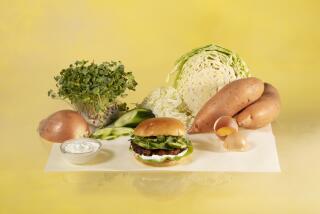Fat: A Little Dab’ll Do Ya
- Share via
The recent and ongoing debate over the amount of fat in the American diet has frightened many people away from good cooking and pleasurable eating. Yet it’s important to remember that there are no bad foods, only bad eating habits--and we shouldn’t forget that fat is a necessary nutritional component in our diet.
Fat’s appealing taste and texture ensured that early humankind received enough calories for the enormous expenditure of energy required to survive. Of course, our environment has changed more quickly in the last 10,000 years than our biological needs, so what once prolonged life is now shortening it. Given the relatively sedentary lifestyle of most Americans these days, only 30% of our total calories should come from fat.
This has made many cooks stop and think about how to make the best use of the least amount of fat so they can maximize its contribution to a dish. Fat has an indescribable tactile presence, and it carries other flavors well. If we reduce the fat used in the cooking process, we can still add it for flavor enhancement.
All cooking methods depend on the transfer of heat from its source to the food being cooked. Hot water vapor is the medium when we steam; boiling water or stock does the job when we poach; and oil transfers heat when we fry and saute.
There are also three direct-heat methods in which heat is transferred from its source to the food. One is grilling, in which the food is placed directly (and closely) over an open flame. The flames and the grate of the grill sear the food. Another is roasting, where hot air is in direct contact with the food.
Yet another method is searing or blackening, in which the food is subjected to the intense heat of a dry, heavy skillet. The food can be rubbed with spices or not--in either case a crust is formed, adding a special flavor. The charm of this method lies in the texture and flavor of the crust.
Steaming and poaching are the most benign ways of cooking--they change a food’s flavor the least. And since they are fat-free, they are the preferred methods for people trying to reduce calories.
Grilling adds a carbonized crust to meats, fish and poultry; it also imparts the flavor of smoke. Don’t waste delicious fat calories oiling the grill or the meat. Instead, grill over red-hot coals, make sure the grill is clean, and don’t try to lift the food every minute to see how it’s cooking. Grill first on one side without disturbing the food, then on the other.
So fear fat less--we know that moderation is the key to a good diet. Don’t waste the fat calories in the cooking, but use them in a way that maximizes the taste and enjoyment of a dish. You might even save enough to butter the bread.
STEAMED VEGETABLES WITH GRAPEFRUIT BUTTER
3/4 cup cauliflower florets
1/4 pound fresh mushrooms
1/4 pound Chinese pea pods, trimmed
2 tablespoons grapefruit juice
1 tablespoon water
1/2 teaspoon salt
1/4 teaspoon ground white pepper
4 teaspoons unsalted butter
Bring water to boil in steamer. Place cauliflower, mushrooms and Chinese peas in top compartment of steamer and steam until barely tender, about 7 minutes.
Combine grapefruit juice, water, salt and pepper in small skillet. Bring to boil over high heat. Immediately remove from heat and swirl in butter.
When vegetables are done, transfer to platter and spoon melted butter sauce over top. Makes 4 servings.
By searing these hamburgers in a dry pan, you save fat calories that can be added in the sauce.
HAMBURGERS AU POIVRE
1 1/2 pounds ground beef
2 tablespoons coarsely ground pepper
1/3 cup red wine
3 tablespoons Dijon mustard
1 tablespoon green peppercorns
1/3 cup whipping cream
1 tablespoon chopped fresh tarragon leaves or 1 teaspoon dried
4 hamburger buns, bottom half only, toasted
Form ground beef into 4 patties, 3/4- to 1-inch thick. Press pepper into both sides to taste. Place patties on plate. Cover and refrigerate.
Combine red wine and mustard in saucepan and place over medium heat. (If using dried tarragon, add to wine-and-mustard mixture.) Simmer until reduced by 1/3, about 5 minutes. Add peppercorns and cream and simmer until liquid becomes sauce-like. Remove from heat and add fresh tarragon. Set aside.
Place large, heavy skillet over high heat. When nearly smoking, add hamburger patties. Cook 3 minutes. Turn patties and cook on other side until desired doneness, about 3 minutes for rare, 6 minutes for medium.
To serve, arrange burgers on toasted bun bottoms and generously spoon some sauce over top of each. Makes 4 servings.
NEW POTATOES IN WHITE WINE
1 1/2 pounds small white new potatoes or small Finnish potatoes
2 cups dry white wine
1/2 cup white vinegar
1 tablespoon unsalted butter
1 teaspoon finely minced garlic
1/4 cup finely minced shallots
1 teaspoon salt
1/2 teaspoon freshly ground black pepper
1/4 cup chopped parsley
1 tablespoon chopped fresh tarragon or 1 teaspoon dried
Rinse unpeeled potatoes under cold water and place in 2-quart pan. Add wine, vinegar, butter, garlic, shallots, salt and pepper. (If using dried tarragon, add to wine and vinegar mixture.) Cover. Bring to boil over high heat. Reduce heat to low and simmer until potatoes are tender, about 15 minutes.
Using slotted spoon, remove potatoes to serving platter and keep warm in oven at 200 degrees. Cook wine-vinegar mixture over high heat, reducing by 1/3. Add parsley and fresh tarragon. Remove potatoes from oven and pour sauce over top. Makes 4 servings.
More to Read
Eat your way across L.A.
Get our weekly Tasting Notes newsletter for reviews, news and more.
You may occasionally receive promotional content from the Los Angeles Times.










